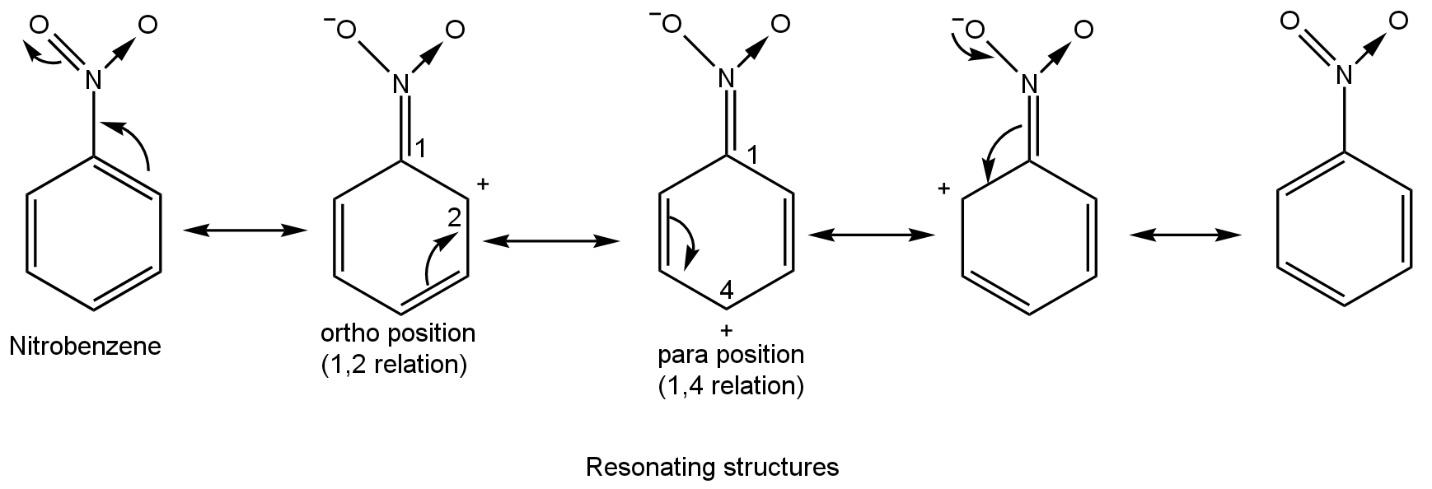
The maximum number of NO2 group that can introduce by nitration of benzene is usually
A. 4
B. 2
C. 3
D. 6
Answer
219k+ views
Hint: Group NO2 is electrophile and thus, during the nitration of benzene this group will attach at the position where there electron density is more. There are three positions in benzene, ortho, meta, and para. Ortho is 1,2 relation, meta is 1,3 relation and para is 1,4 relation as per numbering. Find no. of electron rich positions to get the maximum number of NO2 groups to introduce.
Complete Step by Step Solution:
To know that how much NO2 group will attach on benzene it is required to draw resonating structures of nitrobenzene which firstly form after the first nitration such as

From all resonating structures of nitrobenzene, positive charge resides on ortho and para position with respect to carbon number 1 which is directly attached to the nitro group. Thus, electron density at ortho and para will be less and at meta will be relatively more. Thus, further nitration leads to attaching the NO2 group at meta position.
So, NO2 can attach to meta position with respect to carbon 1 (directly attached to NO2 group). As there are two meta positions thus two NO2 groups can join at this position. Altogether three NO2 groups can be introduced by nitration of benzene.
Thus, the correct option is B.
Note: After nitration of benzene, HNO2 group is attached directly to the ring. As nitrogen is attached to the benzene ring and also directly attached to the oxygen atom, this group will behave as an electron withdrawing group and attract the whole electron density of the ring towards itself.
Complete Step by Step Solution:
To know that how much NO2 group will attach on benzene it is required to draw resonating structures of nitrobenzene which firstly form after the first nitration such as

From all resonating structures of nitrobenzene, positive charge resides on ortho and para position with respect to carbon number 1 which is directly attached to the nitro group. Thus, electron density at ortho and para will be less and at meta will be relatively more. Thus, further nitration leads to attaching the NO2 group at meta position.
So, NO2 can attach to meta position with respect to carbon 1 (directly attached to NO2 group). As there are two meta positions thus two NO2 groups can join at this position. Altogether three NO2 groups can be introduced by nitration of benzene.
Thus, the correct option is B.
Note: After nitration of benzene, HNO2 group is attached directly to the ring. As nitrogen is attached to the benzene ring and also directly attached to the oxygen atom, this group will behave as an electron withdrawing group and attract the whole electron density of the ring towards itself.
Recently Updated Pages
Is PPh3 a strong ligand class 12 chemistry JEE_Main

Full name of DDT is A 111trichloro22bispchlorophenyl class 12 chemistry JEE_Main

Sodium acetate on heating with soda lime produce A class 12 chemistry JEE_Main

Find the isoelectric point pI of Lysine A 556 B 974 class 12 chemistry JEE_Main

The order of basicity among the following compounds class 12 chemistry JEE_Main

The number of isomers in C4H10O are a7 b8 c6 d5 class 12 chemistry JEE_Main

Trending doubts
JEE Main 2026: Application Form Open, Exam Dates, Syllabus, Eligibility & Question Papers

Derivation of Equation of Trajectory Explained for Students

Hybridisation in Chemistry – Concept, Types & Applications

Understanding the Angle of Deviation in a Prism

Understanding Collisions: Types and Examples for Students

Understanding Atomic Structure for Beginners

Other Pages
NCERT Solutions For Class 12 Chemistry Chapter 1 Solutions - 2025-26

NCERT Solutions for Class 12 Chemistry Chapter Chapter 7 Alcohol Phenol and Ether

NCERT Solutions ForClass 12 Chemistry Chapter Chapter 8 Aldehydes Ketones And Carboxylic Acids

JEE Advanced Marks vs Ranks 2025: Understanding Category-wise Qualifying Marks and Previous Year Cut-offs

Haloalkanes and Haloarenes Class 12 Chemistry Chapter 6 CBSE Notes - 2025-26

Solutions Class 12 Chemistry Chapter 1 CBSE Notes - 2025-26




